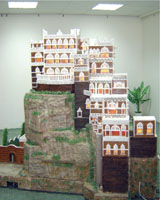
Five million riyal Dar Al-Hajar model on display [Archives:2006/918/Last Page]
February 6 2006
 |
Dar Al-Hajar was the palace of Yemen's Imam. With its stories and the orientation of its facades, the palace commands tremendous views of the valley, in the center of which it stands atop a lofty rock. It was used, often as a summer retreat, by the different dynasties that ruled Yemen and then by the Yemeni imamate from 1602 to 1835. It was built on the ruins of a much older, perhaps pre-Islamic Sabaean structure known as Du Siadan. The rock contains numerous caves used for storage, burying the dead, etc., in addition to a well shaft running from high atop rock down to the water table.
This is the second model of its kind constructed by 57-year-old Al-Ghuthaifi who began this new profession a couple of years ago. “I was a carpenter. After retirement, my children wanted me to rest,” he recalled.
“Rest means rust,” he quipped, “I couldn't remain idle, so I embarked on this type of art. It is fantastic and protects me from the menaces of aging.” He also participated in 2004 Sana'a Arab Culture Capital activities.
The piece is 95 percent accurate and took a year to make, Al-Ghuthaifi said. The first model took nearly the same amount of time but was less accurate at approximately 70 percent. “This time, I was very meticulous. I took the measurements of the palace and the cluster of houses adjacent to it. Every four centimeters in this miniature represents one meter in reality,” he explained.
Al-Ghuthaifi sold the first model to the Republic Presidency for three million riyals. “I hope I can sell this one for five million riyals. That would be a bargain,” he said.
The model weighs 99 kilos and moves on hidden wheels. It also collapses into some 21 pieces. Traditional Yemeni house models usually are made of plaster but this one is made of wood with the help of paste, glass, paint and other artificial additions.
Al-Ghuthaifi now is considering depicting another Yemeni landmark, Sayoun's Al-Sultan Palace in Hadhramout province. “If I am commissioned officially by the Ministry of Culture, I will have to go to Sayoun and spend a couple of weeks to measure the palace's dimensions before I can properly reduce it to a miniature,” he concluded.
——
[archive-e:918-v:14-y:2006-d:2006-02-06-p:lastpage]


